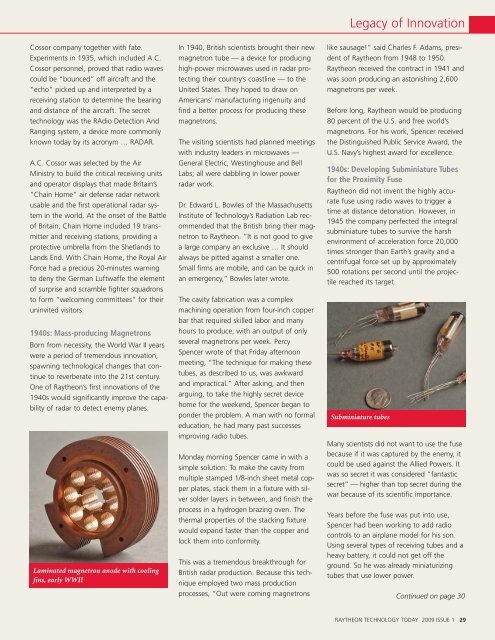2009 Issue 1 - Raytheon
2009 Issue 1 - Raytheon
2009 Issue 1 - Raytheon
Create successful ePaper yourself
Turn your PDF publications into a flip-book with our unique Google optimized e-Paper software.
Cossor company together with fate.<br />
Experiments in 1935, which included A.C.<br />
Cossor personnel, proved that radio waves<br />
could be “bounced” off aircraft and the<br />
“echo” picked up and interpreted by a<br />
receiving station to determine the bearing<br />
and distance of the aircraft. The secret<br />
technology was the RAdio Detection And<br />
Ranging system, a device more commonly<br />
known today by its acronym … RADAR.<br />
A.C. Cossor was selected by the Air<br />
Ministry to build the critical receiving units<br />
and operator displays that made Britain’s<br />
“Chain Home” air defense radar network<br />
usable and the first operational radar system<br />
in the world. At the onset of the Battle<br />
of Britain, Chain Home included 19 transmitter<br />
and receiving stations, providing a<br />
protective umbrella from the Shetlands to<br />
Lands End. With Chain Home, the Royal Air<br />
Force had a precious 20-minutes warning<br />
to deny the German Luftwaffe the element<br />
of surprise and scramble fighter squadrons<br />
to form “welcoming committees” for their<br />
uninvited visitors.<br />
1940s: Mass-producing Magnetrons<br />
Born from necessity, the World War II years<br />
were a period of tremendous innovation,<br />
spawning technological changes that continue<br />
to reverberate into the 21st century.<br />
One of <strong>Raytheon</strong>’s first innovations of the<br />
1940s would significantly improve the capability<br />
of radar to detect enemy planes.<br />
Laminated magnetron anode with cooling<br />
fins, early WWII<br />
In 1940, British scientists brought their new<br />
magnetron tube — a device for producing<br />
high-power microwaves used in radar protecting<br />
their country’s coastline — to the<br />
United States. They hoped to draw on<br />
Americans’ manufacturing ingenuity and<br />
find a better process for producing these<br />
magnetrons.<br />
The visiting scientists had planned meetings<br />
with industry leaders in microwaves —<br />
General Electric, Westinghouse and Bell<br />
Labs; all were dabbling in lower power<br />
radar work.<br />
Dr. Edward L. Bowles of the Massachusetts<br />
Institute of Technology’s Radiation Lab recommended<br />
that the British bring their magnetron<br />
to <strong>Raytheon</strong>. “It is not good to give<br />
a large company an exclusive … It should<br />
always be pitted against a smaller one.<br />
Small firms are mobile, and can be quick in<br />
an emergency,” Bowles later wrote.<br />
The cavity fabrication was a complex<br />
machining operation from four-inch copper<br />
bar that required skilled labor and many<br />
hours to produce, with an output of only<br />
several magnetrons per week. Percy<br />
Spencer wrote of that Friday afternoon<br />
meeting, “The technique for making these<br />
tubes, as described to us, was awkward<br />
and impractical.” After asking, and then<br />
arguing, to take the highly secret device<br />
home for the weekend, Spencer began to<br />
ponder the problem. A man with no formal<br />
education, he had many past successes<br />
improving radio tubes.<br />
Monday morning Spencer came in with a<br />
simple solution: To make the cavity from<br />
multiple stamped 1/8-inch sheet metal copper<br />
plates, stack them in a fixture with silver<br />
solder layers in between, and finish the<br />
process in a hydrogen brazing oven. The<br />
thermal properties of the stacking fixture<br />
would expand faster than the copper and<br />
lock them into conformity.<br />
This was a tremendous breakthrough for<br />
British radar production. Because this technique<br />
employed two mass production<br />
processes, “Out were coming magnetrons<br />
Legacy of Innovation<br />
like sausage!” said Charles F. Adams, president<br />
of <strong>Raytheon</strong> from 1948 to 1950.<br />
<strong>Raytheon</strong> received the contract in 1941 and<br />
was soon producing an astonishing 2,600<br />
magnetrons per week.<br />
Before long, <strong>Raytheon</strong> would be producing<br />
80 percent of the U.S. and free world’s<br />
magnetrons. For his work, Spencer received<br />
the Distinguished Public Service Award, the<br />
U.S. Navy’s highest award for excellence.<br />
1940s: Developing Subminiature Tubes<br />
for the Proximity Fuse<br />
<strong>Raytheon</strong> did not invent the highly accurate<br />
fuse using radio waves to trigger a<br />
time at distance detonation. However, in<br />
1945 the company perfected the integral<br />
subminiature tubes to survive the harsh<br />
environment of acceleration force 20,000<br />
times stronger than Earth’s gravity and a<br />
centrifugal force set up by approximately<br />
500 rotations per second until the projectile<br />
reached its target.<br />
Subminiature tubes<br />
Many scientists did not want to use the fuse<br />
because if it was captured by the enemy, it<br />
could be used against the Allied Powers. It<br />
was so secret it was considered “fantastic<br />
secret” — higher than top secret during the<br />
war because of its scientific importance.<br />
Years before the fuse was put into use,<br />
Spencer had been working to add radio<br />
controls to an airplane model for his son.<br />
Using several types of receiving tubes and a<br />
heavy battery, it could not get off the<br />
ground. So he was already miniaturizing<br />
tubes that use lower power.<br />
Continued on page 30<br />
RAYTHEON TECHNOLOGY TODAY <strong>2009</strong> ISSUE 1 29

















